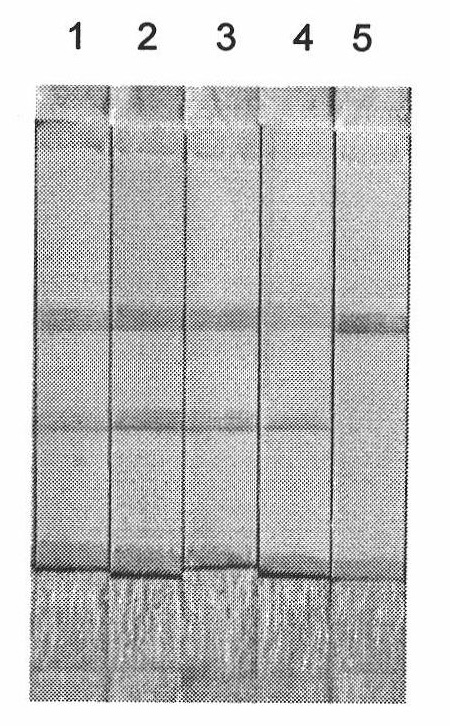Constant temperature amplification detection kit and method for detecting food allergen crustacean gene
A technology of constant temperature amplification detection and crustacean, which is applied in the direction of microbial determination/inspection, biochemical equipment and methods, etc., can solve the problems of unsuitability for rapid detection and wide application, high price, false positives, etc., to meet the needs of high-throughput and low-throughput sample detection, fast response, and simple steps
- Summary
- Abstract
- Description
- Claims
- Application Information
AI Technical Summary
Problems solved by technology
Method used
Image
Examples
Embodiment 1
[0036] Example 1 Composition and preparation of the constant temperature amplification detection kit for food allergen crustacean nucleic acid
[0037] 1. Kit composition:
[0038] a) DNA extraction reagent (lysate): 10mmol / L Tris-HCl (pH8.0), which contains chelex resin with a mass concentration of 1%;
[0039] b) Reaction solution: two peripheral primers (0.05 μmol), two probes (0.5 μmol), and one cross primer (0.5 μmol), 1×Thermol buffer, MgSO 4 (6mmol), dNTPs solution (0.4mmol), Bst DNA polymerase (10U) and sterile double distilled water.
[0040] The two peripheral primers include:
[0041] The forward peripheral primer sequence is 5'-GATTAAGTTACTTTAG-3',
[0042] The reverse peripheral primer sequence was 5'-GATTTAAAGGTCGAACAG-3'.
[0043] Cross primer: 5'-TTCAACATCGAGGTCGCTTTAGGGATAACAGCGT-3'.
[0044] The sequences of the two probes are "5'-TTCAACATCGAGGTCGC-3'" and "5'-TGTCGATATGAACTCTC-3'" respectively, one of which is labeled with biotin at the 5' end and the o...
Embodiment 2
[0050] Embodiment 2 uses kit of the present invention to detect the specific method of food allergen crustacean nucleic acid
[0051]a) Use DNA lysate to extract DNA from the specimen to be tested: add 40 μL of DNA extraction reagent to the specimen test tube, then add 0.5-0.1 g of shrimp chip specimen to the specimen test tube, directly in a boiling water bath for 10 minutes, and centrifuge at 10,000 g for 5 minutes. The supernatant is sample DNA.
[0052] b) Take the sample DNA as a template and add it to the PCR tube containing the reaction solution, and carry out the amplification reaction at 58°C for 80 minutes, including 4 μl of sample DNA and 16 μl of the reaction solution; add the positive control template and negative control template respectively to the control PCR tube.
[0053] c) Put the reacted PCR tube into the nucleic acid anti-pollution detection device for detection, and interpret the result after 15 minutes. When the sample contains food allergen crustacean...
Embodiment 3
[0055] Embodiment 3 detects the specificity of food allergen crustacean nucleic acid with kit of the present invention
[0056] According to the method of Example 2, it is detected whether hairtail, jumping fish, water toad, herring, grass carp, lobster, small shrimp, clam, rice shrimp, blue crab, river prawn, giant giant rosenbergii, prawn, and river crab contain food allergens of crustaceans nucleic acid. The results are as follows:
[0057] serial number
name
Test results
1
Hairtail
-
2
jumping fish
-
3
water toad
-
4
-
5
-
6
lobster
+
7
-
8
clams
+
9
rice shrimp
+
10
blue crab
-
11
river prawns
+
12
Macrobrachium rosenbergii
+
13
prawns
+
14
river crab
+
[0058] Note: "-" means negative, ...
PUM
 Login to View More
Login to View More Abstract
Description
Claims
Application Information
 Login to View More
Login to View More - R&D
- Intellectual Property
- Life Sciences
- Materials
- Tech Scout
- Unparalleled Data Quality
- Higher Quality Content
- 60% Fewer Hallucinations
Browse by: Latest US Patents, China's latest patents, Technical Efficacy Thesaurus, Application Domain, Technology Topic, Popular Technical Reports.
© 2025 PatSnap. All rights reserved.Legal|Privacy policy|Modern Slavery Act Transparency Statement|Sitemap|About US| Contact US: help@patsnap.com


